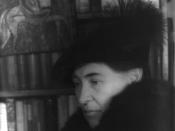The essence of a person lingers in one's memory even long after that person has gone away. In the two modernist novels, A Lost Lady and Passing, the authors were both concerned with that indispensable property that characterizes a person rather than their reality. Larsen and Cather tell the story of women who existed in literature primarily as an incorporeal being. By using the non-traditional topics that classify realist literature, each author builds a woman's essence around the issues of sexuality, race, gender and class. I feel that Willa Cather uses this approach to realism best to carry out the notion of "essence" in her novel. Skaggs paints out that Cather said while creating Marian Forrester in A Lost Lady she "didn't want to make a character study, but just a portrait like a thin miniature painted on ivory. A character study of Mrs. Forrester would have been very, very different."
(Skaggs, pg. 45) Cather keeps the angle the reader sees of Mrs. Forrester strictly from the outside. The reader sees her primarily from Niel, who wants so badly to know the real Marian. The same technique is used by Larsen in Passing, to create an essence for Clare. Except that, Irene, the outside narrator, doesn't want to know Clare. She distorts the image of Clare and misrepresents her true nature.
The issue of gender and sexuality is the most prominent in Cather's novel. When the reader first hears about Marian Forrester, it is from a man's point of view. Skaggs observes that Marian is placed in a male dominant society; "The novel arranges several men around Marian Forrester and uses them to characterize the social attitudes this subject is most likely to provoke. They walk around her and provide angles of vision, as around the famous jus...


